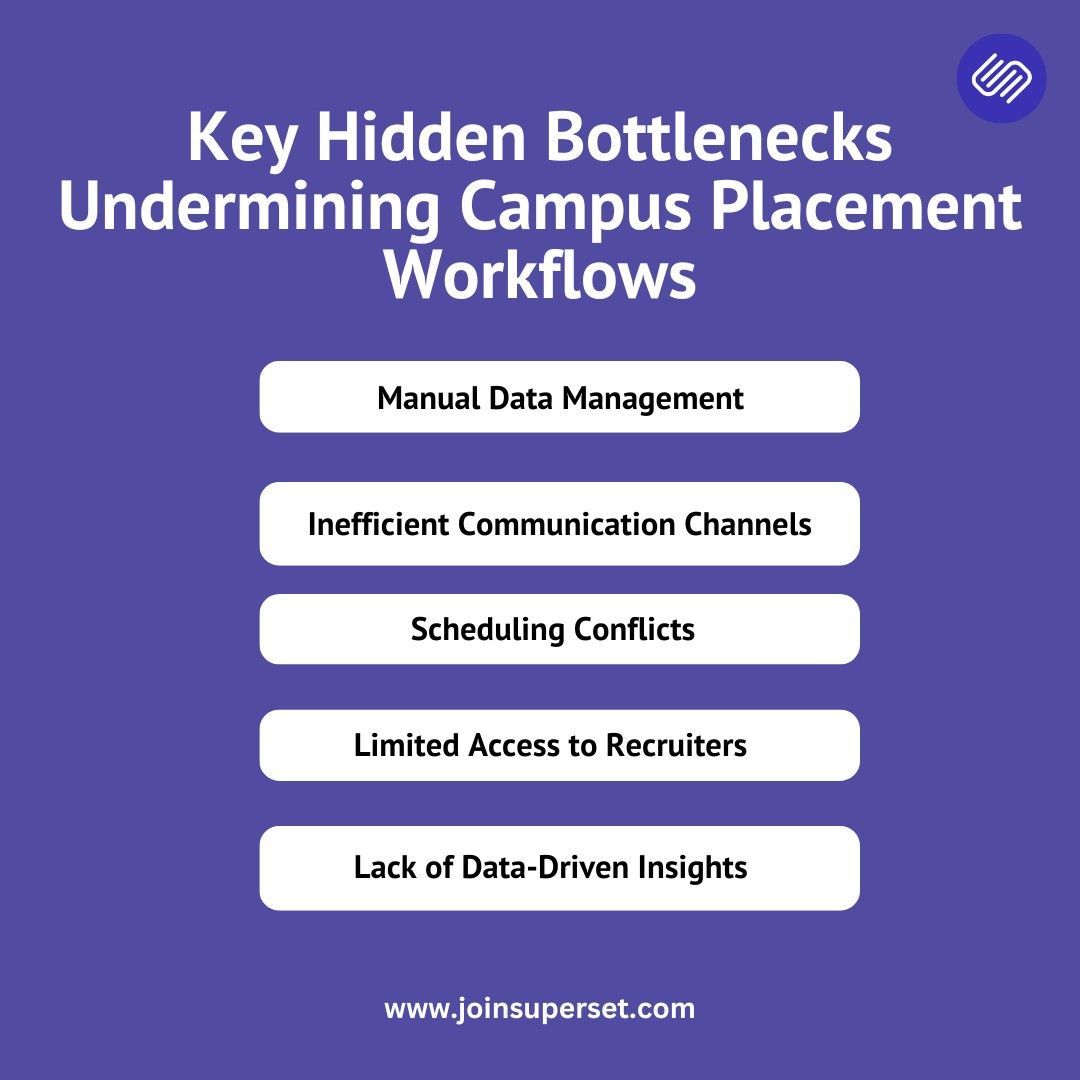Campus placements are pivotal in bridging the gap between academic institutions and the professional world, ensuring students transition smoothly into their careers. However, many universities and colleges grapple with inefficiencies that hinder the effectiveness of their campus placement processes. Identifying these hidden bottlenecks is essential for enhancing the overall experience for students, recruiters, and placement officers. Leveraging solutions like Superset can significantly streamline and optimise these workflows.
Understanding the Campus Placement Workflow
A typical campus placement process encompasses several stages. While the flow seems linear, each stage comes with its own operational and logistical complexities. Let’s break them down:
1. Pre-Placement Preparation: This phase involves engaging with potential recruiters, collecting job descriptions, and scheduling placement drives. Institutions also conduct resume-building workshops, mock interviews, and aptitude training to prepare students. Timely communication and coordination with companies are crucial to ensure a smooth start.
2. Application Process: Students are asked to register, upload resumes, and complete relevant forms based on company requirements. Placement cells must verify eligibility, track preferences, and ensure application accuracy. Without a centralized system, this step can become overwhelming for large batches.
3. Selection Process: This stage includes organizing written tests, group discussions, technical interviews, and HR rounds. It requires flawless scheduling, real-time updates, and seamless coordination between students and recruiters. Any delay or miscommunication here can directly impact selection outcomes.
4. Post-Placement Formalities: After selections, institutions must issue and verify offer letters, collect recruiter feedback, and log placement details. These records are crucial for compliance reporting, audits, and improving future drives. Manual handling often leads to errors and missed insights.
While these stages seem straightforward on paper, underlying bottlenecks — like manual coordination, poor visibility, and lack of standardisation — can significantly reduce placement efficiency. That’s where a solution like Superset makes all the difference.
Hidden Bottlenecks in Campus Placement Workflows

1. Manual Data Management
Relying on spreadsheets and physical records for managing student information and application statuses is prone to errors and inefficiencies. Such manual processes can lead to misplaced documents, data inconsistencies, and time-consuming retrievals.
Solution: Implementing a centralized digital system, like Superset, automates data management, ensuring accuracy and easy access to information. This not only reduces errors but also saves valuable time for placement officers.
2. Inefficient Communication Channels
Traditional communication methods, such as emails and notice boards, often result in missed messages and delays. Students might overlook crucial updates about placement drives, leading to decreased participation and missed opportunities.
Solution: Utilizing platforms that offer real-time notifications and centralized communication ensures that students and recruiters receive timely updates, enhancing engagement and participation.
3. Scheduling Conflicts
Coordinating interviews and tests between multiple recruiters and a large student body can lead to overlapping schedules, causing confusion and missed opportunities.
Solution: An automated scheduling system can efficiently manage and allocate time slots, minimizing conflicts and ensuring a smooth selection process.
4. Limited Access to Recruiters
Universities often struggle to connect with a diverse range of companies, limiting opportunities for students.
Solution: Platforms like Superset provide access to a vast network of recruiters, expanding the pool of potential employers and increasing placement opportunities for students.
5. Lack of Data-Driven Insights
Without analytical tools, placement cells cannot assess the effectiveness of their strategies or identify areas for improvement.
Solution: Integrating analytics into the placement process allows for tracking key performance indicators, facilitating informed decision-making and continuous improvement.
The Role of Campus Placement Automation
Campus placement automation plays a critical role in eliminating inefficiencies and modernizing the entire placement process. Here’s how it transforms each stage:
✅ Streamlining Processes
Automation handles repetitive tasks like application tracking, eligibility filtering, and document verification. This frees up placement officers to focus on student engagement, recruiter relationships, and strategic planning.
✅ Enhancing Communication
Centralized platforms enable real-time notifications, status updates, and announcements. This ensures that students, recruiters, and faculty stay on the same page throughout the placement cycle.
✅ Improving Scheduling
Smart scheduling tools automatically coordinate interview slots, assessments, and deadlines. This minimizes clashes, reduces no-shows, and improves overall drive efficiency.
✅ Expanding Recruiter Networks
Digital placement platforms connect institutions with a diverse pool of recruiters from different industries and geographies. This opens up more opportunities for students beyond traditional partnerships.
✅ Providing Analytical Insights
Automation platforms like Superset offer in-depth reports on placement trends, student performance, and recruiter engagement. These insights help universities continuously refine their strategies and drive better outcomes.
Identifying Hidden Inefficiencies in Legacy Placement Systems
Despite growing placement volumes, many universities still depend on outdated tools like spreadsheets, emails, and standalone software. While these methods may seem manageable, they often introduce hidden inefficiencies that slow down the entire campus placement process. Here’s how:
- Data Silos Across Departments
With no centralized system, student records, recruiter data, and placement statuses are scattered across different files and emails, making it hard to access or update in real time. - Delayed Communication
Manual emails and WhatsApp groups lead to inconsistent and delayed information-sharing between students, faculty, and recruiters. - Error-Prone Manual Tracking
Tracking applications, eligibility, and interview schedules manually increases the chances of errors, missed deadlines, and duplicate entries. - Limited Visibility & Reporting
Without dashboards or analytics, placement officers struggle to evaluate performance, identify bottlenecks, or generate insights for future planning. - Inflexibility in Scaling
As batch sizes and recruiter pools grow, these legacy systems fail to keep up, resulting in poor coordination, lower recruiter satisfaction, and fewer offers.
A modern campus placement automation platform like Superset resolves these issues by centralizing data, automating communication, offering real-time tracking, and enabling seamless scalability — making the placement process faster, smarter, and more reliable.
Building a Future-Ready Placement Cell
Today’s campus placement demands go beyond just scheduling interviews — institutions must think long-term and stay ready for the evolving expectations of both recruiters and students. Superset helps placement cells future-proof their processes by:
- Enabling Alumni Engagement: Track alumni journeys, invite them as mentors, and turn them into hiring advocates for future batches.
- Integrating Career Guidance: Superset’s roadmap includes integration with skilling and career platforms, helping students upskill and align better with job market needs.
- Offering Scalable Architecture: Whether you’re managing 200 or 20,000 students, Superset is designed to grow with you — without compromising performance.
By adopting Superset, universities aren’t just automating tasks — they’re investing in a smart, sustainable placement ecosystem built for tomorrow.
Superset: Transforming Campus Placements
Superset is revolutionizing the way institutions manage campus placements by offering a fully integrated, automation-first platform. As India’s leading placement portal, Superset is built to handle high volumes with precision, speed, and transparency.
- Centralized Data Management
Superset organizes and manages all student profiles, applications, and placement records in one place, eliminating manual errors and scattered data. - Automated Communication
From sending reminders to sharing updates, Superset ensures consistent and timely messaging across students, recruiters, and placement teams. - Efficient Scheduling Tools
The platform streamlines interview and test scheduling, helping avoid clashes and improving coordination between all stakeholders. - Extensive Recruiter Network
With access to 4,600+ recruiters, Superset connects institutions with top companies, opening doors to a broader range of job opportunities for students. - Robust Analytics
Real-time insights into placement performance and trends empower universities to fine-tune their strategies and improve outcomes year over year.
By integrating Superset into their workflows, universities can overcome traditional bottlenecks, leading to a more efficient and effective placement process.
Conclusion
Identifying and addressing hidden bottlenecks in campus placement workflows is crucial for the success of both students and institutions. Embracing campus placement automation through platforms like Superset not only streamlines operations but also enhances the overall placement experience








